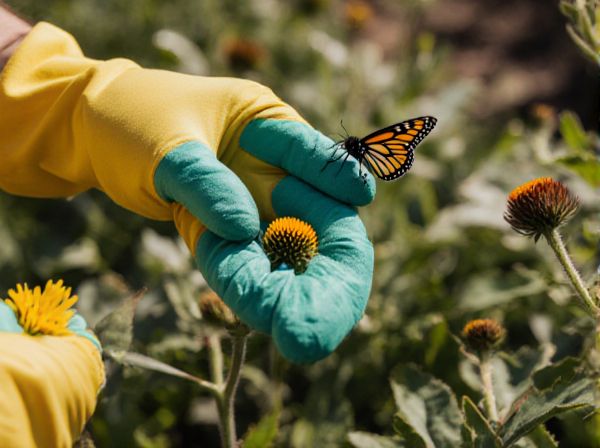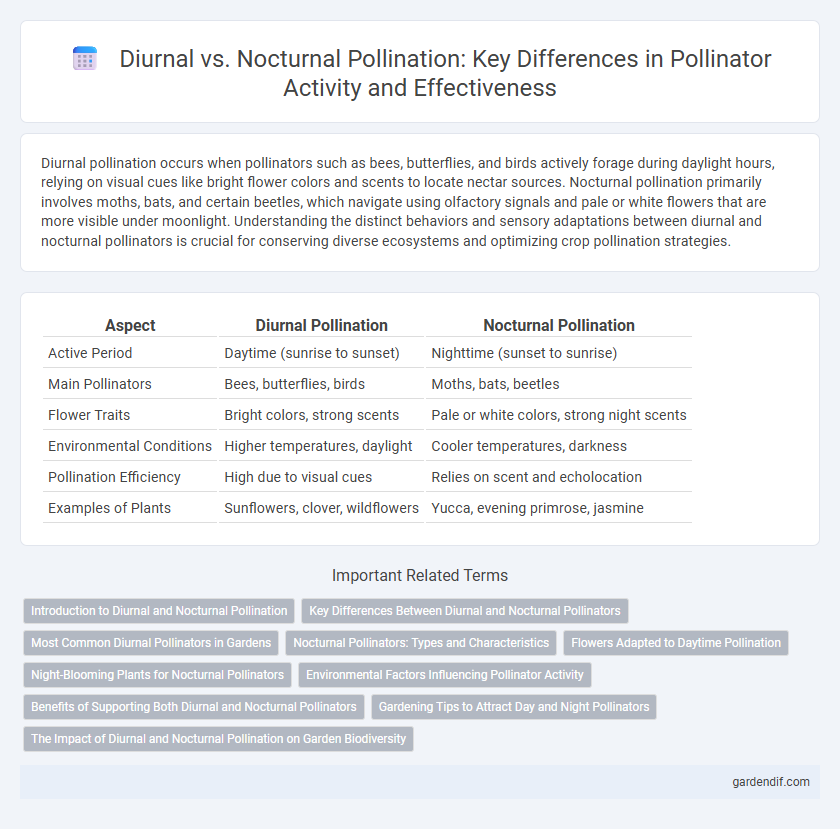
diurnal pollination vs nocturnal pollination Illustration
Diurnal pollination occurs when pollinators such as bees, butterflies, and birds actively forage during daylight hours, relying on visual cues like bright flower colors and scents to locate nectar sources. Nocturnal pollination primarily involves moths, bats, and certain beetles, which navigate using olfactory signals and pale or white flowers that are more visible under moonlight. Understanding the distinct behaviors and sensory adaptations between diurnal and nocturnal pollinators is crucial for conserving diverse ecosystems and optimizing crop pollination strategies.
Table of Comparison
| Aspect | Diurnal Pollination | Nocturnal Pollination |
|---|---|---|
| Active Period | Daytime (sunrise to sunset) | Nighttime (sunset to sunrise) |
| Main Pollinators | Bees, butterflies, birds | Moths, bats, beetles |
| Flower Traits | Bright colors, strong scents | Pale or white colors, strong night scents |
| Environmental Conditions | Higher temperatures, daylight | Cooler temperatures, darkness |
| Pollination Efficiency | High due to visual cues | Relies on scent and echolocation |
| Examples of Plants | Sunflowers, clover, wildflowers | Yucca, evening primrose, jasmine |
Introduction to Diurnal and Nocturnal Pollination
Diurnal pollination occurs during daylight hours and primarily involves pollinators such as bees, butterflies, and birds that rely on visual cues like bright colors and floral patterns. Nocturnal pollination takes place at night, dominated by moths, bats, and certain beetles that use scent and pale-colored flowers to locate nectar sources in low-light conditions. Both pollination types are essential for maintaining biodiversity, supporting ecosystems, and enhancing crop production.
Key Differences Between Diurnal and Nocturnal Pollinators
Diurnal pollinators, such as bees and butterflies, are active during daylight hours and rely heavily on visual cues like bright colors and UV patterns to locate flowers. Nocturnal pollinators, including moths and bats, operate at night and use olfactory signals and pale-colored, fragrant flowers to navigate and feed. These differing sensory adaptations influence plant-pollinator interactions, affecting pollination efficiency and ecological dynamics in various habitats.
Most Common Diurnal Pollinators in Gardens
Bees, butterflies, and hoverflies represent the most common diurnal pollinators in gardens, actively visiting flowers during daylight hours to transfer pollen. These insects benefit from bright colors and abundant nectar in garden plants, enhancing pollination efficiency and plant reproduction. Diurnal pollination supports biodiversity and crop yields by relying on species adapted to the day's light and temperature conditions.
Nocturnal Pollinators: Types and Characteristics
Nocturnal pollinators mainly include moths, bats, and certain beetle species that are active during nighttime hours, relying on olfactory cues and pale or white flowers for navigation. These pollinators exhibit adaptations such as enhanced sensory organs for low-light environments, including large eyes in moths and robust echolocation abilities in bats. Their role complements diurnal pollinators by targeting night-blooming plants, ensuring continuous pollination across different temporal niches.
Flowers Adapted to Daytime Pollination
Flowers adapted to daytime pollination often exhibit bright colors such as yellow, blue, and white to attract diurnal pollinators like bees, butterflies, and hummingbirds. These flowers usually produce abundant nectar and emit sweet fragrances during daylight hours to enhance pollinator visitation. Structural adaptations include open shapes and landing platforms, facilitating efficient pollination by visually oriented daytime animals.
Night-Blooming Plants for Nocturnal Pollinators
Night-blooming plants have evolved to attract nocturnal pollinators such as moths, bats, and certain beetles by producing strong fragrances and pale or white flowers visible in low light. These adaptations optimize pollination efficiency during nighttime when diurnal pollinators like bees are inactive. Nocturnal pollination plays a crucial ecological role by supporting biodiversity and ensuring the reproduction of specialized plant species.
Environmental Factors Influencing Pollinator Activity
Environmental factors such as temperature, light intensity, and humidity critically influence diurnal and nocturnal pollinator activity, impacting their foraging efficiency and flower visitation rates. Diurnal pollinators like bees rely on sunlight and warm temperatures to activate their flight muscles, whereas nocturnal pollinators such as moths and bats are adapted to cooler, lower light conditions and often depend on moonlight or other ambient sources. Wind patterns and floral scent emissions also vary between day and night, further shaping pollinator behavior and pollination success in different environmental contexts.
Benefits of Supporting Both Diurnal and Nocturnal Pollinators
Supporting both diurnal and nocturnal pollinators enhances overall plant reproductive success by maximizing pollination coverage across different times of the day, thereby increasing crop yields and biodiversity. Diurnal pollinators like bees and butterflies efficiently transfer pollen during daylight, while nocturnal pollinators such as moths and bats ensure pollination continuity during night hours, helping maintain ecosystem resilience. This 24-hour pollination service promotes genetic diversity and stabilizes food webs vital for sustainable agriculture and natural habitats.
Gardening Tips to Attract Day and Night Pollinators
Attracting diurnal pollinators such as bees and butterflies requires planting brightly colored, nectar-rich flowers like lavender, coneflowers, and sunflowers that bloom during daylight hours. For nocturnal pollinators like moths and bats, incorporate pale, night-blooming plants such as moonflowers, evening primrose, and jasmine, which release strong fragrances after dusk. Providing water sources, avoiding pesticides, and creating sheltered habitats enhance the presence of both day and night pollinators in your garden.
The Impact of Diurnal and Nocturnal Pollination on Garden Biodiversity
Diurnal pollination primarily involves bees, butterflies, and other daytime-active insects, which enhances plant reproduction diversity by supporting a wide range of flowering species that bloom under sunlight. Nocturnal pollination, carried out mainly by moths, bats, and certain beetles, plays a crucial role in sustaining plant species that have evolved to bloom at night, contributing significantly to garden biodiversity. The complementary activities of diurnal and nocturnal pollinators ensure continuous pollination across a 24-hour cycle, promoting a richer and more resilient garden ecosystem.
diurnal pollination vs nocturnal pollination Infographic

 gardendif.com
gardendif.com